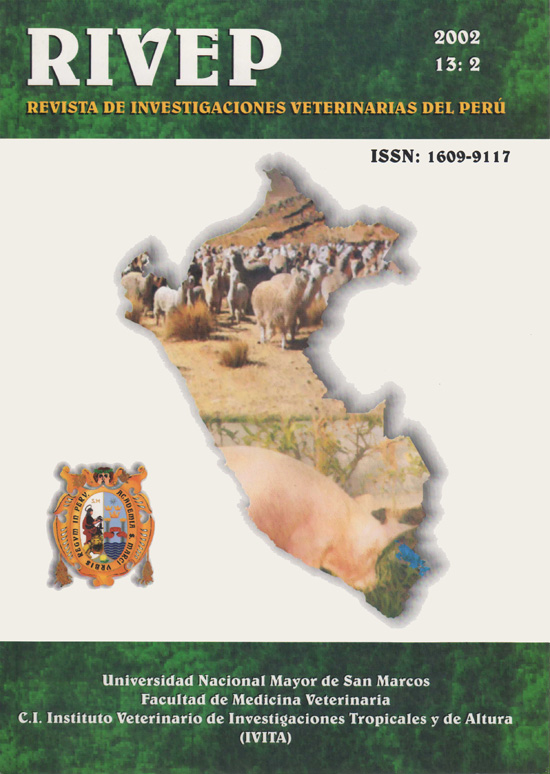ENGORDE DE LLAMAS BAJO DIFERENTES REGÍMENES ALIMENTICIOS
DOI:
https://doi.org/10.15381/rivep.v13i2.7246Keywords:
llama, age, nutritional regime, fattening, cultivated pastureAbstract
The present study was carried out at IVITA-Maranganí Experimental Station to evaluate the animal response to fattening in llamas of two ages submitted to different nutritional regimes in two seasons. An irrestricted randomize design with 2 x 2 x 3 factorial arrangement (two ages: 1 and 2; two seasons: rainy and dry; and three nutritional regimes: natural pasture, mixture of phalaris + clover, and mixture ofryegrass + clover) was used. A total of 60 male llamas (30 of one year and 30 of two years old) were used during a 90-day period of fattening. The stocking rate was 5, 10 and 10 animals/ha for natural pasture, phalaris + clover, and ryegrass + clover, respectively. The body weight gain was evaluated at different periods: 0-30, 31-60, 61-90, 0-60 and 0-90 days (d). Differences in body weight gain was observed in llamas of two years old (183 g/d) as compared with those of one year of age (146 g/d; P<0.05) in the period 0-30d. Body weight gain was better during the rainy (l 7lg/d) than in the dry season (136 g/d; P< 0.05). The best nutritional regime was ryegrass + clover ( 199 g/d) and phalaris + clover ( 182 g/d) as compared to natural pasture (78 g/d; P<0.05). The largest body weight gain was in the period 0-60 d (178 g/d). The best economic merit were was obtained in the ryegrass + clover pasture (5.81 % ) and in phalaris + clover ( 4.29%) in the period 0-60 d. lt is concluded that the largest body weight gain and the best economic merit were achieved in cultivated pastures.Downloads
Downloads
Published
Issue
Section
License
Copyright (c) 2002 Wilber García V., Felipe San Martín H., César Novoa M., Enrique Franco LL.

This work is licensed under a Creative Commons Attribution-NonCommercial-ShareAlike 4.0 International License.
AUTHORS RETAIN THEIR RIGHTS:
a. Authors retain their trade mark rights and patent, and also on any process or procedure described in the article.
b. Authors retain their right to share, copy, distribute, perform and publicly communicate their article (eg, to place their article in an institutional repository or publish it in a book), with an acknowledgment of its initial publication in the Revista de Investigaciones Veterinarias del Perú (RIVEP).
c. Authors retain theirs right to make a subsequent publication of their work, to use the article or any part thereof (eg a compilation of his papers, lecture notes, thesis, or a book), always indicating the source of publication (the originator of the work, journal, volume, number and date).



